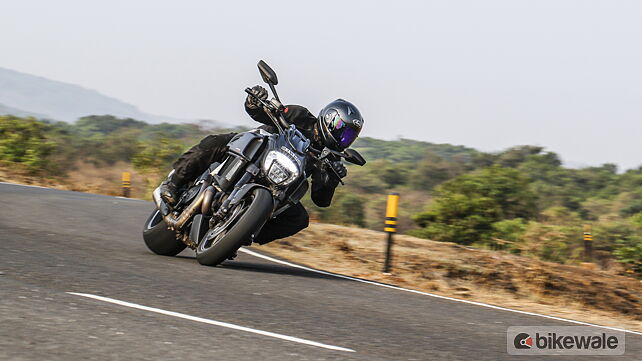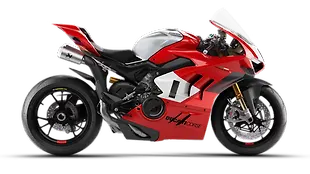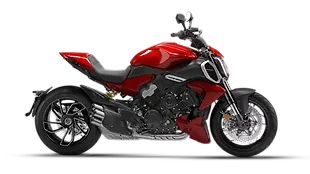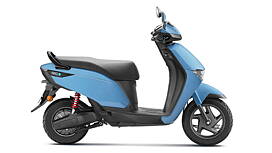What is it?

Beautifully thought-out, superbly executed and genre shattering; that’s the 2015 Ducati Diavel for you. And compared to the original that came out in 2011, it is more desirable as well. In terms of design, the new iteration of the Diavel might sport the same silhouette, but it now gets an all-LED headlamp, nicer looking wheels, revised radiator covers, new LED side indicators and a new seat. The latter is now larger...and more comfortable. The megaphone exhausts are new too. And they look menacing.
There are changes to the engine as well. It is essentially the same 1198cc L-Twin liquid cooled Testrastretta 11 degree unit from the older Diavel, but with revised intake and exhaust ports, new cam timing, higher compression ratio and relocated injectors for better, fuller combustion. The end result is the exact same 162bhp of max power but a peak torque figure that’s about 10Nm higher at 130Nm. Ducati also claims, the torque arrives earlier and traces a flatter curve than before, making the Diavel more ride-able.
Time to find out if it is…

How does it ride?

The last time I rode a Diavel (it was the older iteration), it was in the Himalayas along with – how do I say this – lesser machinery, if you will. No wonder the Diavel stood out. And even today when it comes to this Ducati (and the Multistrada), I mostly have good things to say.
So imagine my surprise when I got on the newer bike and within minutes I didn’t like it all that much. The riding position is still great. It’s neither laid back (read cruiser), nor demanding (street naked), and it’s easy to grip that large tank. Overall, it’s a nice balance between control and comfort. The new Diavel also has a light and progressive clutch action; weight distribution that masks its 239kg kerb weight when on the move and a throttle action that’s light and linear but not sharp enough to cause jerkiness.
My problem then is with the Diavel’s ride quality. If you are based out of Delhi or Hyderabad where roads are smooth and nicely tarmac-ed, you needn’t worry. But, if you have concrete roads to deal with, especially those with low-amplitude-high-frequency undulations (like in Mumbai), you are in for some difficult times. The Diavel bounces about constantly, especially its rear, leaving you uncomfortable and a tad disappointed.

Disappointed because apart from the harsh ride (and the engine heat), the Diavel would make for such a lovely everyday commute bike. I also would have preferred a little less on-throttle shudder from the drivetrain at lower revs and a smoother operating gearbox. The current 6-speed unit is just too clunky to fit the bike’s price or positioning.
This apart, the new Diavel is a fun motorcycle. In the city, one needs to ride it to believe it as to how easy it is to filter through traffic with. Part throttle will take you past traffic in a jiffy as the bike rides its potent torque curve. Hit the open road and unless you check yourself, you will be sitting on the quicker side of 200kmph in no time…without trying! It’s crazy.
And if you open it up from a standstill, its sheer acceleration is bound to make you giggle like (pardon the cliché) a schoolgirl. Every time. Needless to say touring in the low hundreds on the Diavel is like munching chocolates; you can do it all day long, untiringly.

But, you’d expect that given the image the Diavel cuts, that of a ‘power cruiser’. However, the way it corners and brakes can shame many a street nakeds. It doesn’t like low speed corners like hairpin bends for instance given its heavy steering. But around long sweeping bends or even when tackling quick direction changes, the Diavel feels planted, eager and talkative.
The chassis, the front end and the tyres give you enough feedback and more to keep going at corners harder and faster with every run. And the brakes – Brembo twin discs with monobloc 4-piston calipers – have the bite, progression and feel and stopping ability that one would rarely associate with a motorcycle with a raked out front; this is proper supersports stuff.

Anything else I should know?

The Diavel with its low 770mm seat height is surprisingly manageable. It also gets a nicely concealed rear grab handle and smart luggage straps as standard riveted under the seat. But, the new Diavel’s highlight has to be its electronics and instrumentation. It gets ride-by-wire, a slipper clutch, 8-level traction control system, ABS, keyless start and go, and of course, an all-LED headlamp. An Audi effect or not, the LEDs work superbly in the dark with enough throw and range.

The Ducati also gets three pre-programmed riding modes. Urban: With power limited to 100bhp, it gets duller throttle response and traction control turned up to 5. Touring: All of the 162 horses are available, but with a duller throttle response, one can only feel them galloping close to the redline. The traction control is set to 3 here. Sport: With traction control set to the least intrusive setting of 1, and all of 162bhp of power available with sharp and quick throttle response, this mode really brings out the best in the Diavel. And the rider. The most entertaining. And the most rewarding mode, by far.

Now to the instrumentation. It’s a two-tier setup. The one on top is more conventional. It has a dot matrix like display and throws up info on speed, engine revs and coolant temperature. The lower deck is an all colour TFT screen with all the info you might ever want, but would rarely need. To name a few, there’s average speed and fuel economy; range and ambient temperature readouts; and of course mode display with the traction control level the bike’s running.

Why should I buy one?

Apart from maybe the Diavel Carbon White’s pricing (which touches Rs 20 lakh on the road) and its unnecessarily stiff ride, this Ducati has everything going for it. No wonder, the bike sells so well (at least for a bike that can easily be classified as exorbitant). But, it’s the base Diavel Black that sells most. And honestly, if we were to buy one we too would settle for the Black; it’s almost Rs 3.5 lakh cheaper than the Carbon White for the same thrills, same ability and similar street presence.

Where does it fit in?

The only competition we can think of for the Diavel is the Yamaha Vmax. But, since we haven’t ridden one and haven’t seen one on Indian roads and since it costs an even more ridiculous Rs 31 lakh on the road, we’d have to say, the Diavel really is in a class of its own.

Photography by Kapil Angane
Click here to read the Ducati Multistrada First Ride Review
Click here to read the Kawasaki ZX-14R First Ride Review
Gallery
1/43
Double Tap to Zoom
















































